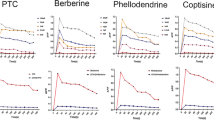Abstract
Compound K (CK) is a major metabolite of ginsenosides that is absorbed. CK has antidiabetic effects, although the mechanisms underlying the effects of CK have not fully been known. To elucidate the mechanisms underlying the antidiabetic effects of CK, we studied the effects of CK on GLP-1 secretion from NCI-H716 cells, and explored the mechanisms underlying CK-induced GLP-1 secretion. Treatment of NCI-H716 cells with 10, 50, and 100 μM CK significantly increased GLP-1 secretion, and intracellular Ca2+ and cAMP levels in a dose-dependent manner. Transfection of NCI-H716 cells with siRNA specific to α-gustducin and siRNA specific to TAS1R3 had no effect on CK-induced GLP-1 secretion and Ca2+ increase. However, transfection of NCI-H716 cells with TGR5-specific siRNA significantly inhibited CK-induced GLP-1 secretion and the increase in Ca2+ and cAMP levels. Moreover, CK showed human TGR5 agonist activity in CHO-K1 cells transiently transfected with human TGR5. Our data provide a novel mechanism of CK for antidiabetic effects. Moreover, the findings might suggest that CK is a potential agent that has multiple biological functions in the body via GLP-1 secretion and TGR5 activation.




Similar content being viewed by others
References
Behrens, M., and W. Meyerhof. 2011. Gustatory and extragustatory functions of mammalian taste receptors. Physiology & Behavior 105: 4–13.
Brubaker, P.L. 2010. Minireview: Update on incretin biology: Focus on glucagon-like peptide-1. Journal of Endocrinology 151: 1984–1989.
Di Matteo, M.A., A.C. Loweth, S. Thomas, J.G. Mabley, N.G. Morgan, J.R. Thorpe, and I.C. Green. 1997. Superoxide, nitric oxide, peroxynitrite and cytokine combinations all cause functional impairment and morphological changes in rat islets of langerhans and insulin-secreting cell lines but dictate cell death by different mechanism. Apoptosis 2: 164–177.
Drucker, D.J. 2006. The biology of incretin hormones. Cell Metabolism 3: 153–165.
Han, G.C., S.K. Ko, J.H. Sung, and S.H. Chung. 2007. Compound K enhances insulin secretion with beneficial metabolic effects in db/db mice. Journal of Agricultural Food Chemistry 55: 10641–10648.
Huang, Y.C., C.Y. Lin, S.F. Huang, H.C. Lin, W.L. Chang, and T.C. Chang. 2010. Effect and mechanism of ginsenosides CK and Rg1 on stimulation of glucose uptake in 3T3-L1 adipocytes. Journal of Agricultural Food Chemistry 58: 6039–6047.
Jang, H.J., Z. Kokrashvili, M.J. Theodorakis, O.D. Carlson, B.J. Kim, J. Zhou, H.H. Kim, X. Xu, S.L. Chan, M. Juhaszova, M. Bernier, B. Mosinger, R.F. Magolskee, and J.M. Egan. 2007. Gut-expressed gustducin and taste receptors regulate secretion of glucagon-like peptide-1. Proceedings of the National Academy of Science of the United States of America 104: 15069–15074.
Kim, D.Y., H.D. Yuan, I.K. Chung, and S.H. Chung. 2009. Compound K, intestinal metabolite of ginsenoside, attenuates hepatic lipid accumulation via AMPK activation in human hepatoma cells. Journal of Agricultural Food Chemistry 57: 1532–1537.
Kim, K., D.H. Kim, and H.Y. Kim. 2010. Compound K protects MIN6N8 pancreatic β-cells against palmitate-induced apoptosis through modulating SAPK/JNK activation. Cell Biology International 34: 75–80.
Lee, J., E. Lee, D. Kim, J. Lee, J. Yoo, and B. Koh. 2009. Studies on absorption, distribution and metabolism of ginseng in humans after oral administration. Journal of Ethnopharmacology 122: 143–148.
Li, W., M. Zhang, J. Gu, Z.J. Meng, L.C. Zhao, Y.N. Zheng, C. Li, and G.L. Yang. 2012. Hypoglycemic effect of protopanaxadiol-type ginsenosides and compound K on type 2 diabetes mice induced by high-fat diet combining with streptozotocin via suppression of hepatic gluconeogenesis. Fitoterapia 83: 192–198.
Lim, G.E., and P.L. Brubaker. 2006. Glucagon-like peptide 1 secretion by the L-cell: The view from within. Diabetes 55: S70–S77.
Pols, T.W.H., L.G. Noriega, M. Nomura, J. Auwerx, and K. Schooljans. 2011. The bile acid membrane receptor TGR5 as an emerging target in metabolism and inflammation. Journal of Hepatology 54: 1263–1272.
Reimann, F., A.M. Habib, G. Tolhurst, H.E. Parker, G.J. Roser, and F.M. Gribble. 2008. Glucose sensing in L cells: A primary cell study. Cell Metabolism 8: 532–539.
Reimann, F., G. Tolhurst, and F.M. Gribble. 2012. G-protein-coupled receptors in intestinal chemosensation. Cell Metabolism 4: 421–431.
Reimer, R.A., C. Darimont, S. Gremlich, V. Nicolas-Metral, U.T. Ruegg, and K. Mace. 2001. A human celluar model for studying the regulation of glucagon-like peptide-1 secretion. Journal of Endocrinology 142: 4522–4528.
Steinert, R.E., and C. Begliner. 2011. Nutrient sensing in the gut: Interactions between chemosensory cells, visceral afferents and the secretion of satiation peptides. Physiology & Behavior 105: 62–70.
Thomas, C., A. Gioiello, L. Noriega, A. Strehle, J. Oury, G. Rizzo, A. Macchiarulo, H. Yamamoto, C. Mataki, M. Pruzanski, J. Auwerx, and K. Schoonjans. 2009. TGR5-mediated bile acid sensing controls glucose homeostasis. Cell Metabolism 10: 167–177.
Yoon, S.H., E.J. Han, J.H. Sung, and S.H. Chung. 2007. Anti-diabetic effects of compound K versus compound K-metformin combination therapy in diabetic db/db mice. Biological and Pharmaceutical Bulletin 30: 2196–2200.
Yuan, H.D., S.J. Kim, and S.H. Chung. 2011. Beneficial effects of IH-901 on glucose and lipid metabolism via activating adenosine monophosphate-activated protein kinase and phosphatidylinositol-3 kinase pathways. Metabilism 60: 43–51.
Acknowledgments
This work was supported by the Korea Food Research Institute (the grant number E0131203) and the National Research Foundation of Korea (grant number 2010-0024475).
Author information
Authors and Affiliations
Corresponding author
Rights and permissions
About this article
Cite this article
Kim, K., Park, M., Lee, Y.M. et al. Ginsenoside metabolite compound K stimulates glucagon-like peptide-1 secretion in NCI-H716 cells via bile acid receptor activation. Arch. Pharm. Res. 37, 1193–1200 (2014). https://doi.org/10.1007/s12272-014-0362-0
Received:
Accepted:
Published:
Issue Date:
DOI: https://doi.org/10.1007/s12272-014-0362-0




